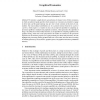Free Online Productivity Tools
i2Speak
i2Symbol
i2OCR
iTex2Img
iWeb2Print
iWeb2Shot
i2Type
iPdf2Split
iPdf2Merge
i2Bopomofo
i2Arabic
i2Style
i2Image
i2PDF
iLatex2Rtf
Sci2ools
98
Voted
COLT
2004
Springer
2004
Springer
Graphical Economics
: We introduce a graph-theoretic generalization of classical Arrow-Debreu economics, in which an undirected graph specifies which consumers or economies are permitted to engage in direct trade, and the graph topology may give rise to local variations in the prices of commodities. Our main technical contributions are: (1) a general existence theorem for graphical equilibria, which require local markets to clear; (2) an improved algorithm for computing approximate equilibria in standard (non-graphical) economies, which generalizes the algorithm of Deng et al. [2002] to non-linear utility functions; (3) an algorithm for computing equilibria in the graphical setting, which runs in time polynomial in the number of consumers in the special but important case in which the graph is a tree (again permitting non-linear utility functions). We also highlight many interesting learning problems that arise in our model, and relate them to learning in standard game theory and economics, graphical gam...
Related Content
| Added | 01 Jul 2010 |
| Updated | 01 Jul 2010 |
| Type | Conference |
| Year | 2004 |
| Where | COLT |
| Authors | Sham Kakade, Michael J. Kearns, Luis E. Ortiz |
Comments (0)

